Even if you’re a complete beginner and have never played the piano in your life, I am going to show you how to play the blues. You don’t have to learn any fancy scales or play for years before you attempt this tutorial – you just need an open mind, and of course a piano or keyboard!
Playing the piano is a lot easier than most other instruments as you don’t have to learn how to make the sound. All you need to do is hit a note and hey presto, you are playing the piano. Of course, you’d always prefer to know which keys to hit, and playing the blues is not as hard as you might think – even if you’ve never touched a piano in your life!
So grab that dusty old keyboard out of the loft, or pull the cover off your old and battered piano and get started today. Here’s my awesome guide for beginners on how to play piano blues…
Let’s start with the basics
Here is an overhead view of the keys of a piano or keyboard. As you can see I have added the name of the notes on each key, and learning and remembering which note is which is a lot easier than you might think…
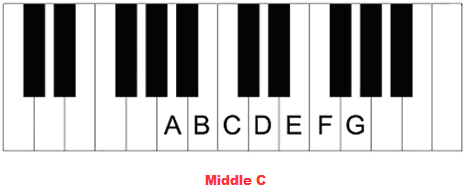
On a piano or keyboard, there are literally only seven notes of the alphabet that repeat over and over. Once you get to the note ‘G’ it will start back at A again and go B, C, D, and so on. So if you’ve ever wondered what the notes are on a piano, then now you know – and it isn’t as hard as you probably thought!
I have indicated that we are looking at the centre of a piano or keyboard by highlighting the ‘middle C’ note. To find this on your instrument all you need to do is find the most central C on your keys. It doesn’t matter how many keys you have, and you don’t need a full 88 note piano to do this. Just go to the very middle of your keys and find the ‘middle C’.
Knowing the first seven letters of the alphabet is the easy part, but knowing where the ‘A’ starts is not so. However, I find the best way to locate the notes on a piano is to remember just two notes rather than all seven. You will notice that there are a total of five individual black keys that sit over the top of the seven individual notes. These are called sharps and flats, but we will come back to that later.
The two notes we need to remember are the ‘C’ and the ‘F’. The reason why I choose these notes is because the ‘C’ sits to the left of the two black keys, and the ‘F’ sits to the left of the three black keys.
Why should I remember two notes instead of just one?
You could of course just remember where one of the notes is and go up or down on the seven note alphabet to find the rest, however I find it’s much quicker if you know at least two of the notes so you don’t have to navigate too far.
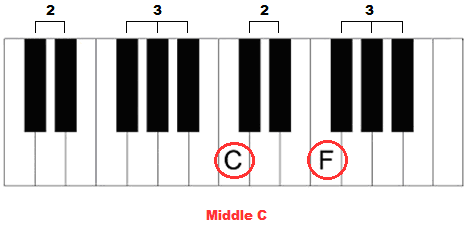
So now that you can quickly identify the above two notes C and F, you can easily find any of the other five. For example, to find D we just have to locate C and move up one. To find the note E we can either go up two from C or go down one from F – the choice is yours!
How to work out what the black keys are
Now that we can identify the white notes we can now begin to learn what the black notes are called. This is very simple and all we have to remember is that they are also named using the same seven notes of the alphabet, but instead also use the term ‘flat’ or ‘sharp’.
What are flats and sharps?
Let’s start with the black key which is directly above and to the right of the middle C (or any C for that matter)…

The term ‘sharp’ or to ‘sharpen a note’ means to move up by one semi-tone. A semi-tone is the distance of just one note. So if we were to move up one semi-tone from C, we would get to the above note which is C sharp, or more commonly written as C#.
One way of looking at the black keys is thinking of them as extensions to the white keys. So a black key to the right of a note is called a ‘sharp’ of the white note before it. Let’s take a look at F sharp (F#)…

You can see that this works the same as it did for C#, and we take the white note and just add the term ‘sharp’ and move to the black key – simples!
The flat keys are just the opposite of the sharp
The term ‘flat’ or to ‘flatten a note’ means the opposite, and rather than go up one semi-tone (one note interval) we drop down a semi-tone and go in the opposite direction. This means that the same black key can have two names. For example, C# can also be known as D flat (or Db).
Take a look at the alternative flat keys for both C# and F#…
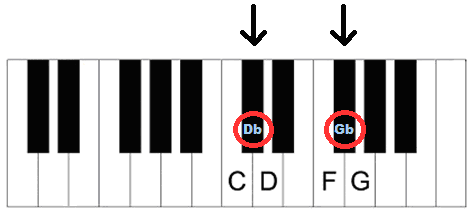
Which black keys will I need to use to play the blues?
There are three black keys you’ll need to know to play my tutorial song – Eb, F# and Bb. Here are the notes to help you find them…

Familiarise yourself with these three black notes as you will be using these all the time when you play blues piano. In order to play the piano blues tutorial coming up, we need to also learn three white notes. Here they are along with the three black keys we’ve just discovered…

That gives us a total of six notes (or seven if you count the C again), which is all we need to play blues on the piano. They are – C, Eb, F, F#, G and Bb.
What notes do I play in the left hand?
So far we have covered what notes to play in our right hand, and now we are going to look at our left hand. Here is what I want you to play in the left hand…
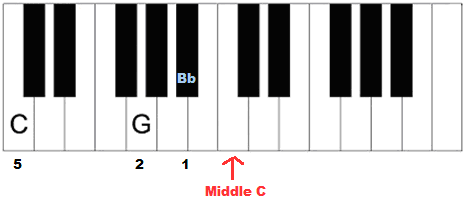
I have indicated which fingers to use in your left hand with the numbers underneath each of the three notes. So for C you will use your 5th finger (little), the G is played with the 2nd finger (forefinger) and the Bb is played with the 1st (thumb).
These three notes are all played at the same time to form a chord which is known as C7. This is what we are going to play underneath our right hand melody which is coming up. You are one step closer to playing an amazing piano blues for the first time!
Let’s play the blues!
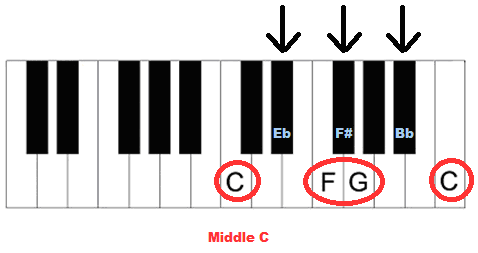
These are your right hand notes which you will need to practice before you decide to play both hands together. Try playing them one after the other starting from the bottom and playing to the top. Then when you are more comfortable with the notes you can practice playing them back down again, constantly playing them up and down one after the other.
What do these notes sound like? Am I playing them correctly?
If you want to know if you are playing this correctly, here’s how the right hand will sound if you play the notes up and down –
Here is how the left hand will sound when played on its own as a chord –
When playing both hands together it will sound like this –
Here’s an extra chord to try out for the left hand
As an added bonus I would also like you to try this fantastic blues left hand – the F7. Here are the notes…
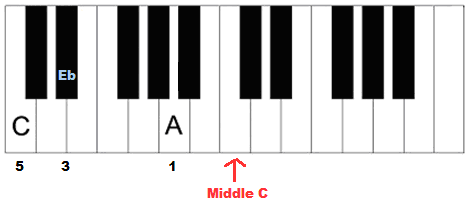
You can play the exact same right hand notes over the top, and it will still sound great. Try changing between these two chords to mix things up a little. Play a few times up and down with the right hand, and then change the left hand chord and see what you think.
Here’s what it will sound like when you change the left hand chord –
Learn to play piano blues online with me
My online blues course teaches blues piano from scratch and builds your ability in a modular way. As you progress through the course, you’ll learn left hands, right hands, bridges and endings which you’ll use together to make your own blues piano compositions. I’ll show you the blues scale early on, giving you everything you need to start improvising – and we’ll progress to advanced licks and an impressive tutorial song to consolidate your new skills. Finally, we’ll move onto some popular blues songs, including music by the great Jerry Lee Lewis and my own personal favourite, Ray Charles.
I charge just £19.99 for 6 full months access, with 58 videos and counting – that’s less than the cost of a single piano lesson! – and I offer a 100% satisfaction money back guarantee.

How much is that is US dollars?
That really depends on the current conversion rate. I would advise searching on Google to get an accurate price in USD from GBP 🙂
How much is this in US dollars?
My current price of £19.99 for 6 months access is around $19-$20 US dollars.
Thanks Will sign up
HI Martin! I am a classically pianist by training. I perform and teach all over the “Lowcountry” of South Carolina. I want to expand my own repertoire and depth of knowledge so I am seeking a blues teacher. I appreciate how you carefully, succinctly explain concepts and offer audio feedback. I am considering purchasing your 58 video course. You offer a terrific price! Question: If a student has detailed questions, are you also available for 1:1 consultations?
Hi Melissa, yes I am happy to answer any questions you have. You can simply email me here – [email protected], or message me via the live chat service on the website 🙂
hi Martin
are there some pdf to download?? best regards roberto
Hi Roberto, once you are subscribed to the course you are able to download and print the sheet music for each tutorial that requires it 🙂
Hi Martin,
I am a blues guitar player.
1. What other keys besides C will we be learning?
2. Do you cover Major Pentatonic as well?
Doug
Hi Doug, thank you for your questions. The key of C is the main key that I teach in the video course for the basics and advanced foundations of learning to play a left hand blues or boogie woogie rhythm. This also includes lots of right hand riffs over the top of these left hand bass lines. I do also cover how to improvise in A and D minor. The reason why the foundations of the course are mainly in the key of C is because I would need to double if not triple the size of the course just to cover a couple more keys, like G and F. However, how I personally learned to play in other keys was to learn as much material as I could in C and then transpose over to other keys. It’s also worth noting that because of the physicality of the piano that some keys are easier to pick up as they almost feel the same to play. For example, playing the blues in the key of G is very similar to C physically. Whereas playing in B flat would be completely different to C. But B flat and E flat are very similar. So once you learn to play in a key you can often quickly pick up a couple of other keys because they are similar, and so on. I don’t cover the major pentatonic as this is more of a guitar thing than something that is covered in piano. As for scales, I only cover a blues scale in my course and I don’t look at traditional major, minor or pentatonic scales. Again, this is mainly because of the size of the course and trying to condense as much as possible within it. With around 60 videos I try to cover as much as possible, and my videos also cover tutorials specifically for songs only, like Great Balls of Fire, Hit the Road Jack, and so on. Feel free to email me directly if you would like a faster response – [email protected], always happy to help 🙂